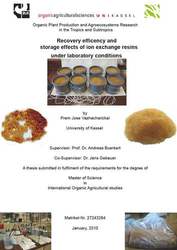| Departments | |
|---|---|
| Book Series (96) |
1378
|
| Nachhaltigkeit |
3
|
| Gesundheitswesen |
1
|
| Humanities |
2365
|
| Natural Sciences |
5406
|
| Mathematics | 229 |
| Informatics | 319 |
| Physics | 980 |
| Chemistry | 1363 |
| Geosciences | 131 |
| Human medicine | 243 |
| Stomatology | 10 |
| Veterinary medicine | 108 |
| Pharmacy | 147 |
| Biology | 835 |
| Biochemistry, molecular biology, gene technology | 121 |
| Biophysics | 25 |
| Domestic and nutritional science | 45 |
| Agricultural science | 1004 |
| Forest science | 201 |
| Horticultural science | 20 |
| Environmental research, ecology and landscape conservation | 148 |
| Engineering |
1793
|
| Common |
98
|
|
Leitlinien Unfallchirurgie
5. Auflage bestellen |
|
Advanced Search
Recovery efficency and storage effects of ion exchange resins under laboratory conditions (English shop)
Prem Jose Vazhacharickal (Author)Preview
Extract, PDF (620 KB)
Table of Contents, PDF (510 KB)
Ion exchangers are used for isotope separation in nuclear industry and for purification of water. The advantages of ion exchange technology consist of the possibility to remove highly diluted contaminants and their insensitivity to variations in flow and concentration. Ion exchange resins are chemically active and highly stable in their physical and chemical structure. Due to these specific properties, they will not contaminate products. The main objectives of this study were to determine the background contamination of commercially available ion exchange resins, effective pre-treatment (washing) methods, efficiency of resins in capturing various nutrients applied and the best methods for the storage of the resins. Resin rinsing with 1.0 M NaCl was highly effective, although it did not eliminate the problem of high K+ contamination in the resins. Pre-treatment with 1 M NaCl had no major effect on the absorption behaviour of NO3-. At the 20% saturation level, resin washing and fast flow of the nutrient solution certainly reduces the absorption capacity of the ion exchange resins. However, against our expectations at 80% saturation, the combined effects of washing and slow flow of nutrients increased the sorption capacity of ion exchange resins to a certain extent. The analysis of the leachate solution revealed that NH4+ and NO3- were below detection limit in the leachate solution suggesting the complete absorption of these ions by ion exchange resins irrespective of the applied nutrient concentration. The washing with 1.0 M NaCl solution seems to be the best of our treatments but there are still additional impurities from exchange resins being responsible for excessive recovery rate. Better recovery of nutrients in refrigerator treatments compared to air dry, oven dry and deep freezer recommends that this method is the best storage treatment.
| ISBN-13 (eBook) | 9783736900363 |
| Language | English |
| Page Number | 78 |
| Edition | 1. |
| Publication Place | Göttingen |
| Publication Date | 2014-09-04 |
| General Categorization | Master's thesis |
| Departments |
Agricultural science
|
| Keywords | Background contamination, Extraction, Ion exchange resins, Recovery rate |








